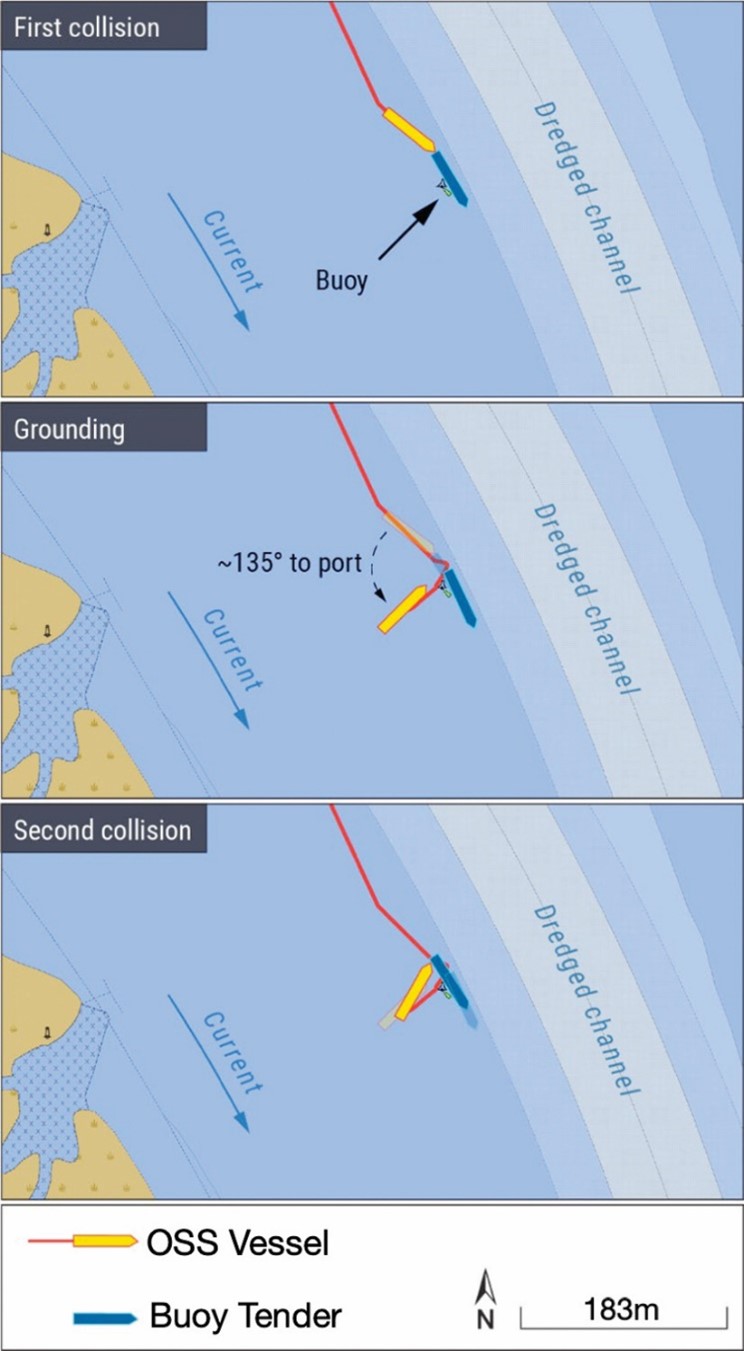Too many assumptions and too little communication can lead to bad outcomes. That is what The Nautical Institute has to say about an accident in which an offshore supply vessel collided with a Coast Guard buoy tender twice in 45 minutes. The incident is covered in the latest Mars Reports.
The Nautical Institute gathers reports of maritime accidents and near-misses. It then publishes these so-called Mars Reports (anonymously) to prevent other accidents from happening. A summary of this incident:
A Coast Guard buoy tender was working in a restricted river waterway to service buoys that were shifted or missing due to a recent hurricane. The bridge team consisted of, among others, two officers and the master. It was full daylight and visibility was good. The tender, displaying day-shapes for a vessel restricted in her ability to manoeuvre, was working near the edge of the navigable channel with the ebb current astern.
An offshore supply (OSS) vessel left berth upstream of the buoy tender and was outbound. Around this time, the buoy tender crew had secured a large buoy on deck; the crew were heaving in the chain while an officer on the bridge used the DP system to position-check the deadweight anchor.
Also read: ‘Don’t assume other vessels will stay clear of you’
As they approached, the master of the OSS vessel contacted the buoy tender via VHF radio to request a ‘one-whistle’ passing arrangement; that is, the OSS vessel would overtake (pass) the tender on their starboard side – outside the channel. The request was unusual, but the bridge team of the buoy tender assumed the OSS vessel bridge team knew what they were doing and did not query it. On board the OSS vessel, the master had assumed – without consulting his electronic chart system (ECS) – that the buoy tender (and buoy) were ‘off-station’ and that there was enough water on the starboard side.
At 1542, the OSS vessel made a slight course change to starboard in preparation for passing the buoy tender on their starboard side. Up to that point, the OSS vessel had been making about 13 knots. As the OSS vessel approached the buoy tender, the reading on its depth sounder dropped quickly, so the master aborted his attempt to pass starboard of the buoy tender. Now faced with the imminent danger of collision, he then reversed the OSS vessel’s engines and used the bow thruster and rudder to turn to port in to try to avoid hitting the buoy tender.
A safety officer on the deck of the buoy tender radioed the bridge about the impending collision. The commanding officer made a ship-wide announcement to prepare the crew for collision while the conning officer sounded five short blasts on the ship’s whistle.

At 1544, the OSS vessel’s bow collided with the stern of the stationary buoy tender while making 6 knots. The OSS vessel then pivoted and slid down the tender’s starboard side and grounded on the mud banks to the starboard of the buoy tender. Some 45 minutes later, with the buoy tender still in the same position, the OSS vessel re-floated.
The master attempted to manoeuvre around the buoy tender’s stern but the ebb current set the OSS vessel onto the stationary Coast Guard vessel. Recognizing that a second collision was imminent, the buoy tender’s master made another ship-wide announcement warning the crew to brace for impact. The offshore supply vessel’s starboard bow struck the tender’s starboard quarter.

Investigation findings
The investigation found, among other things, that;
- The OSS vessel’s master had assumed that the stationary buoy tender’s position was not at the edge of the channel. This led to his decision to pass the buoy tender on its starboard side. Last minute manoeuvres, first to avoid grounding then to avoid collision with the buoy tender, were unsuccessful. Contributing to the collision was the buoy tender crew not questioning the passing arrangement proposed by the OSS vessel’s master.
- The buoy tender remained connected to the heavy buoy anchor on the sea bottom and was therefore unable to manoeuvre and evade the OSS vessel. If the crews had communicated more fully with each other, they might have agreed for the OSS vessel to wait until the buoy tender could move on.
Also read: Nautical Institute: ‘Confirm other vessel’s movements instead of making assumptions’
Mars Reports
This accident was covered in the Mars Reports, originally published as Mars 202238, that are part of Report Number 359. A selection of this Mars Report was also published in SWZ|Maritime’s October 2022 issue. The Nautical Institute compiles these reports to help prevent maritime accidents. That is why they are also published (in full) on SWZ|Maritime’s website.
More reports are needed to keep the scheme interesting and informative. All reports are read only by the Mars coordinator and are treated in the strictest confidence. To submit a report, please use the Mars report form.
Also read: Assumptions and poor communication lead to vessel collision








